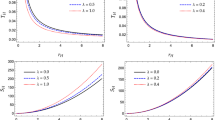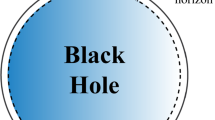Abstract
It has been recently shown in Chatterjee and Ghosh (Phys Rev Lett 125:041302, 2020, https://doi.org/10.1103/PhysRevLett.125.041302) that microstate counting carried out for quantum states residing on the horizon of a black hole leads to a correction of the form \(\exp (-A/4l_p^2)\) in the Bekenstein-Hawking form of the black hole entropy. In this paper, we develop a novel approach to obtain the possible form of the spacetime geometry from the entropy of the black hole for a given horizon radius. The uniqueness of this solution for a given energy-momentum tensor has also been discussed. Remarkably, the black hole geometry reconstructed has striking similarities to that of noncommutative-inspired Schwarzschild black holes (Nicolini et al. in Phys Lett B 632:547, 2006). We also obtain the matter density functions using Einstein field equations for the geometries we reconstruct from the thermodynamics of black holes. These also have similarities to that of the matter density function of a noncommutative-inspired Schwarzschild black hole. The conformal structure of the metric is briefly discussed and the Penrose–Carter diagram is drawn. We then compute the Komar energy and the Smarr formula for the effective black hole geometry and compare it with that of the noncommutative-inspired Schwarzschild black hole. We also discuss some astrophysical implications of the solutions. Finally, we propose a set of quantum Einstein vacuum field equations, as a solution of which we obtain one of the spacetime solutions obtained in this work. We then show a direct connection between the quantum Einstein vacuum field equations and the first law of black hole thermodynamics.




Similar content being viewed by others
Data Availability
The manuscript has no data associated with it.
Notes
Note that we are considering black holes where the line element is given as \(ds^2=-f(r)dt^2+\frac{1}{f(r)}dr^2+r^2d\Omega ^2\).
In [27], the exponential corrections were shown to be dominant for microscopic black holes. In case of such a black hole, \(r-\tilde{r}_+\) is a very small quantity for which one can generally use the near horizon expansion while computing \(r_*\). One obtains \(r_*=\frac{1}{f'(\tilde{r}_+)}\left( r+\ln \left| \frac{r}{\tilde{r}_+}-1\right| \right) \). Hence, again \(r_*\) goes to zero in the \(r\rightarrow 0\) limit.
References
Einstein, A.: Die Feldgleichungen der Gravitation, Sitzungsber Preuss Akad Wiss, p. 844 (1915)
Einstein, A.: Die Grundlage der allgemeinen Relativitätstheorie. Ann. Phys. 49, 769 (1916). https://doi.org/10.1002/andp.19163540702
Bekenstein, J.D.: Black holes and the second law. Lett. Nuovo Cimento 4, 737 (1972). https://doi.org/10.1007/BF02757029
Bekenstein, J.D.: Black Holes and Entropy. Phys. Rev. D 7, 2333 (1973). https://doi.org/10.1103/PhysRevD.7.2333
Hawking, S.W.: Black hole explosions? Nature 248, 30 (1974). https://doi.org/10.1038/248030a0
Hawking, S.W.: Particle creation by black holes. Commun. Math. Phys 43, 199 (1975). https://doi.org/10.1007/BF02345020
Hawking, S.W.: Black holes and thermodynamics. Phys. Rev. D 13, 191 (1976). https://doi.org/10.1103/PhysRevD.13.191
Bardeen, J.M., Carter, B., Hawking, S.W.: The four laws of black hole mechanics. Commun. Math. Phys. 31, 161 (1973). https://doi.org/10.1007/BF01645742
Amati, D., Ciafaloni, M., Veneziano, G.: Can spacetime be probed below the string size? Phys. Lett. B. 216, 41 (1989). https://doi.org/10.1016/0370-2693(89)91366-X
Konishi, K., Paffuti, G., Provero, P.: Minimum physical length and the generalized uncertainty principle in string theory. Phys. Lett. B 234, 276 (1990). https://doi.org/10.1016/0370-2693(90)91927-4
Rovelli, C.: Loop quantum gravity. Living. Rev. Relativ. 1, 1 (1998). https://doi.org/10.12942/lrr-1998-1
Carlip, S.: Quantum gravity: a progress report. Rep. Prog. Phys. 64, 885 (2001). https://doi.org/10.1088/0034-4885/64/8/301
Girelli, F., Livine, E.R., Oriti, D.: Deformed special relativity as an effective flat limit of quantum gravity. Nucl. Phys. B 708, 411 (2005). https://doi.org/10.1016/j.nuclphysb.2004.11.026
Strominger, A., Vafa, C.: Microscopic origin of the Bekenstein–Hawking entropy. Phys. Lett. B 379, 99 (1996)
Dijkgraaf, R., Verlinde, E.P., Verlinde, H.L.: Counting dyons in N = 4 string theory. Nucl. Phys. B 484, 543 (1997)
Ashtekar, A., Baez, J., Corichi, A., Krasnov, K.: Quantum geometry and black hole entropy. Phys. Rev. Lett. 80, 904 (1998). https://doi.org/10.1103/PhysRevLett.80.904
Kaul, R.K., Majumdar, P.: Logarithmic correction to the Bekenstein–Hawking entropy. Phys. Rev. Lett. 84, 5255 (2000). https://doi.org/10.1103/PhysRevLett.84.5255
Domagala, M., Lewandowski, J.: Black-hole entropy from quantum geometry. Class. Quantum Gravit. 21, 5233 (2004). https://doi.org/10.1088/0264-9381/21/22/014
Meissner, K.A.: Black-hole entropy in loop quantum gravity. Class. Quantum Gravit. 21, 5245 (2004). https://doi.org/10.1088/0264-9381/21/22/015
Ghosh, A., Mitra, P.: An improved estimate of black hole entropy in the quantum geometry approach. Phys. Lett. B 616, 114 (2005)
Mandal, I., Sen, A.: Black hole microstate counting and its macroscopic counterpart*. Class. Quantum Gravit. 27, 214003 (2010). https://doi.org/10.1088/0264-9381/27/21/214003
Banerjee, R., Gangopadhyay, S., Modak, S.K.: Voros product, noncommutative Schwarzschild black hole and corrected area law. Phys. Lett. B 686, 181 (2010)
Dabholkar, A., Gomes, J., Murthy, S.: Counting all dyons in \(\cal{N} \)=4 string theory. J. High Energy Phys. 2011, 59 (2011). https://doi.org/10.1007/JHEP05(2011)059
Gangopadhyay, S., Roychowdhury, D.: Corrected area law and Komar energy for noncommutative inspired Reissner–Nordström black hole. Int. J. Mod. Phys. A 27, 1250041 (2012). https://doi.org/10.1142/S0217751X12500418
Gangopadhyay, S.: Voros product and noncommutative inspired black holes. Mod. Phys. Lett. A 28, 1350030 (2013). https://doi.org/10.1142/S0217732313500302
Dabholkar, A., Gomes, J., Murthy, S.: Nonperturbative black hole entropy and Kloosterman sums. J. High Energy Phys. 2015, 74 (2015). https://doi.org/10.1007/JHEP03(2015)074
Chatterjee, A., Ghosh, A.: Nonperturbative black hole entropy and Kloosterman sums. Phys. Rev. Lett. 125, 041302 (2020). https://doi.org/10.1103/PhysRevLett.125.041302
Rovelli, C.: Quantum Gravity (Cambridge Monographs on Mathematical Physics). Cambridge University Press, Cambridge
Doplicher, S., Fredenhagen, K., Roberts, J.E.: Spacetime quantization induced by classical gravity. Phys. Lett. B 331, 39 (1994). https://doi.org/10.1016/0370-2693(94)90940-7
Doplicher, S., Fredenhagen, K., Roberts, J.E.: The quantum structure of spacetime at the Planck scale and quantum fields. Commun. Math. Phys. 172, 187 (1995). https://doi.org/10.1007/BF02104515
Douglas, M.R., Nekrasov, N.A.: Noncommutative field theory. Rev. Mod. Phys. 73, 977 (2001). https://doi.org/10.1103/RevModPhys.73.977
Nicolini, P., Smailagic, A., Spallucci, E.: Noncommutative geometry inspired Schwarzschild black hole. Phys. Lett. B 632, 547 (2006)
Ansoldi, S., Nicolini, P., Smailagic, A., Spalucci, E.: Non-commutative geometry inspired charged black holes. Phys. Lett. B 645, 261 (2007)
Chaichian, M., Tureanu, A., Zet, G.: Corrections to Schwarzschild solution in noncommutative gauge theory of gravity. Phys. Lett. B 660, 573 (2008)
Nicolini, P.: Noncommutative black holes, the final appeal to quantum gravity: a review. Int. J. Mod. Phys. A 24, 1229 (2009). https://doi.org/10.1142/S0217751X09043353
Banerjee, R., Gangopadhyay, S.: Komar energy and Smarr formula for noncommutative inspired Schwarzschild black hole. Gen. Relativ. Gravit. 43, 3201 (2011). https://doi.org/10.1007/s10714-011-1250-2
Voros, A.: Wentzel-Kramers-Brillouin method in the Bargmann representation. Phys. Rev. A 40, 6814 (1989). https://doi.org/10.1103/PhysRevA.40.6814
Gradshteyn, I.S., Ryzhik, I.M.: Table of Integrals, Series and Products, 7th edn. Academic Press, Amsterdam (2007)
Arraut, I., Batic, D., Nowakowski, M.: Maximal extension of the Schwarzschild space-time inspired by noncommutative geometry. J. Math. Phys. 51, 022503 (2010). https://doi.org/10.1063/1.3317913
Jacobson, T.: Thermodynamics of Spacetime: The Einstein Equation of State. Phys. Rev. Lett. 75, 1260 (1995). https://doi.org/10.1103/PhysRevLett.75.1260
Arbey, A., Auffinger, J., Geiller, M., Livine, E.R., Sartini, F.: Hawking radiation by spherically-symmetric static black holes for all spins: Teukolsky equations and potentials. Phys. Rev. D 103, 104010 (2021). https://doi.org/10.1103/PhysRevD.103.104010
Morris, M.S., Thorne, K.S.: Wormholes in spacetime and their use for interstellar travel: a tool for teaching general relativity. Am. J. Phys. 56, 395 (1988). https://doi.org/10.1119/1.15620
Graves, J.C., Brill, D.R.: Oscillatory Character of Reissner-Nordström Metric for an Ideal Charged Wormhole. Phys. Rev. 120, 1507 (1960). https://doi.org/10.1103/PhysRev.120.1507
Komar, A.: Covariant conservation laws in general relativity. Phys. Rev. 113, 934 (1959). https://doi.org/10.1103/PhysRev.113.934
Wald, R.M.: General Relativity. University Press, Chicago (1984)
Smarr, L.: Mass formula for Kerr black holes. Phys. Rev. Lett. 30, 71 (1973). https://doi.org/10.1103/PhysRevLett.30.71. (Erratum, https://doi.org/10.1103/PhysRevLett.30.521 Phys. Rev. Lett. 30 (1973) 521)
Padmanabhan, T.: Gravitation: Foundations and Frontiers. Cambridge University Press, Cambridge (2010)
Acknowledgements
We thank the referees for making useful and valuable comments which have helped us to improve the manuscript substantially.
Author information
Authors and Affiliations
Corresponding author
Ethics declarations
Conflict of interest
The authors declare no Conflict of interest.
Additional information
Publisher's Note
Springer Nature remains neutral with regard to jurisdictional claims in published maps and institutional affiliations.
Appendices
Apppendix 1: Quantum corrected Einstein equations for \(h(r)=r^2\)
In the earlier part of our analysis after obtaining Eq. (37), we have considered the classical Einstein equation with matter density function \(\rho (r)\) given in Eq. (48) to prove the uniqueness of our solution. In this section, we look for quantum corrections to the Einstein equations. We now propose a set of modified Einstein vacuum field equations. The quantum Einstein vacuum field equations involving the \(\{t,t\}\) and \(\{r,r\}\) components of the quantum modified Einstein tensor \(\bar{G}_{tt}\) and \(\bar{G}_{rr}\) are proposed as follows
where
Similarly, the other two quantum modified vacuum field equations are proposed as
where
In Eqs. (89, 91), \(\bar{G}_{tt}\), \(\bar{G}_{rr}\), \(\bar{G}_{\theta \theta }\), and \(\bar{G}_{\phi \phi }\) denotes the quantum modified Einstein tensor. Solving Eq. (89) or Eq. (91) perturbatively, we obtain the form of the metric f(r) given in Eq. (37). It is important to observe that both Eqs. (89, 91) are vacuum field equations.
It is important to note that there are no solid justifications for the quantum Einstein equations in Eqs. (89–92) at this moment. In order to obtain the quantum corrections, we have absorbed the energy-momentum tensor into the left hand side of the Einstein field equations and proposed the resultant object as the quantum vacuum Einstein field equation giving rise to the solution f(r) in Eq. (37).
Appendix 2: Quantum corrected Einstein equations and its connection to the first law of black hole thermodynamics for \(h(r)=r^2\)
We shall now exploit the analytical form of \(r^2f(r)\bar{G}_{rr}\) given in Eq. (89) around the horizon radius \(\tilde{r}_+\) given in Eq. (23). In the limit \(r\rightarrow \tilde{r}_+\), Eq. (89) can be expressed (upto \(\mathcal {O}\left( \exp \left( -\pi r_+^2/l_p^2\right) \right) \)) as follows
We now multiply both sides of the above equation with \(\frac{c^4}{2G}d\tilde{r}_+\) and obtain the following relation
The left hand side of the above equation can be rearranged as
In this relation the term in the parenthesis is the temperature of the black hole whose metric is given by Eq. (37). Invoking the form of the horizon from Eq. (23), we finally obtain the following relation
where we have identified \(A=4\pi r_+^2\) with \(r_+\) being the usual Schwarzschild radius. Now from Eq. (18), we can see that for \(n=0\) case, the modified entropy formula is \(S=\frac{k_BA}{4l_p^2}-k_Be^{-\frac{A}{4l_p^2}}\). With this identification, we can recast Eq. (96) given as
which is the usual first law of black hole thermodynamics. The above analysis establishes a direct connection between geometry and thermodynamics [47]. It is also important to identify that the pressure term at the horizon is zero leading to the conclusion that we are dealing with a vacuum field equation. This indeed is a nice consistency check of the proposed quantum Einstein equations in Eqs. (89, 92).
Rights and permissions
Springer Nature or its licensor (e.g. a society or other partner) holds exclusive rights to this article under a publishing agreement with the author(s) or other rightsholder(s); author self-archiving of the accepted manuscript version of this article is solely governed by the terms of such publishing agreement and applicable law.
About this article
Cite this article
Sen, S., Saha, A. & Gangopadhyay, S. Signatures of quantum geometry from exponential corrections to the black hole entropy. Gen Relativ Gravit 56, 57 (2024). https://doi.org/10.1007/s10714-024-03241-9
Received:
Accepted:
Published:
DOI: https://doi.org/10.1007/s10714-024-03241-9




